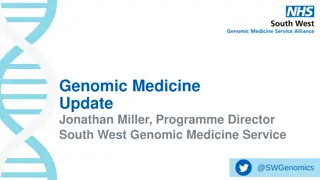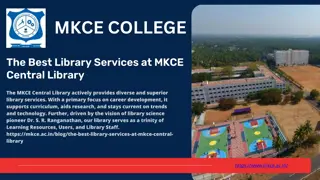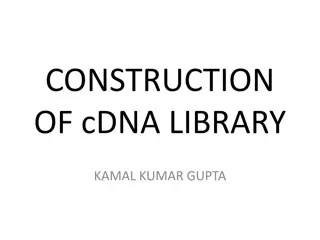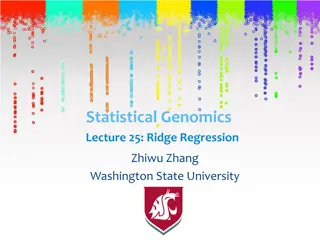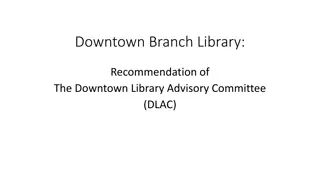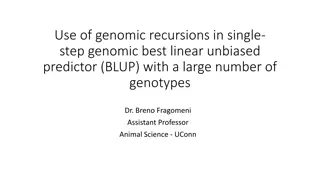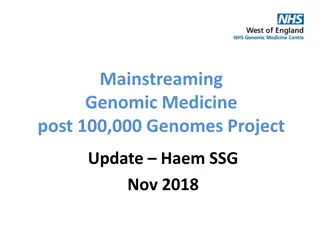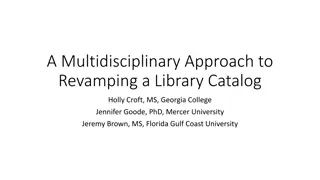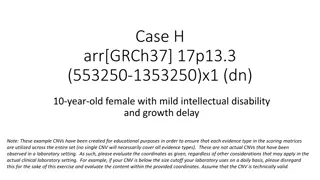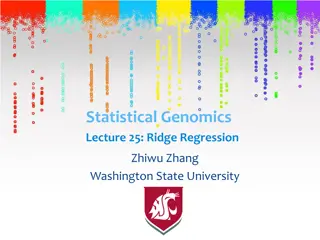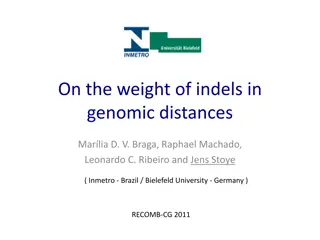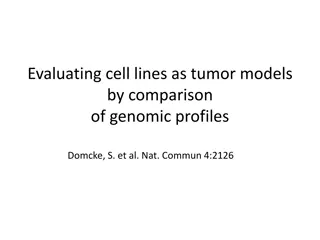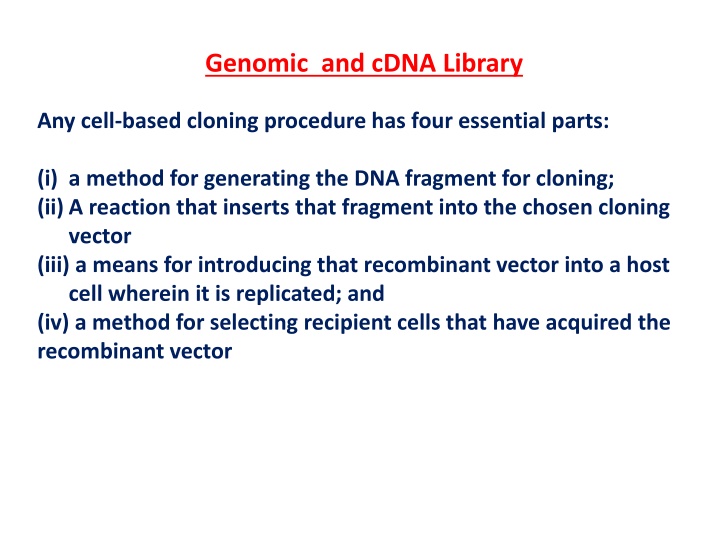
Genomic and cDNA Library Construction for Gene Isolation
Learn about the essential parts of cell-based cloning procedures for isolating genes from complex sources like genomic DNA using genomic and cDNA libraries. Explore strategies, steps, and the importance of genomic libraries in gene isolation.
Download Presentation

Please find below an Image/Link to download the presentation.
The content on the website is provided AS IS for your information and personal use only. It may not be sold, licensed, or shared on other websites without obtaining consent from the author. If you encounter any issues during the download, it is possible that the publisher has removed the file from their server.
You are allowed to download the files provided on this website for personal or commercial use, subject to the condition that they are used lawfully. All files are the property of their respective owners.
The content on the website is provided AS IS for your information and personal use only. It may not be sold, licensed, or shared on other websites without obtaining consent from the author.
E N D
Presentation Transcript
Genomic and cDNA Library Any cell-based cloning procedure has four essential parts: (i) a method for generating the DNA fragment for cloning; (ii) A reaction that inserts that fragment into the chosen cloning vector (iii) a means for introducing that recombinant vector into a host cell wherein it is replicated; and (iv) a method for selecting recipient cells that have acquired the recombinant vector
We want to isolate a single gene from the human genome, in which case the target sequence could be diluted over a million fold by unwanted genomic DNA. We need to find some way of rapidly sifting through, or screening, large numbers of unwanted sequences to identify our particular target. There are two major strategies for isolating sequences from complex sources such as genomic DNA. The first, a cell-based cloning strategy, is to divide the source DNA into manageable fragments and clone everything. Such a collection of clones, representative of the entire starting population, is known as a library. We must then screen the library to identify our clone of interest, using a procedure that discriminates between the desired clone and all the others.
The second strategy is to selectively amplify the target sequence directly from the source DNA using the polymerase chain reaction (PCR), and then clone this individual fragment. 1. Genomic Library >>A library encompassing an entire genome is called a genomic library. A genomic library is a collection of the total genomic DNA from a single organism. To construct a genomic library, the organism's DNA is extracted from cells and then digested with a restriction enzyme to cut the DNA into fragments of a specific size. The fragments are then inserted into the vector using DNA ligase. Next, the vector DNA is then transferred to host organism - commonly a population of Escherichia coli or yeast - with each cell containing only one vector molecule.
Steps for creating a genomic library from a large genome 1. Extract and purify DNA: 2. Digest the DNA with a restriction enzyme. This creates fragments that are similar in size, each containing one or more genes. 3. Insert the fragments of DNA into vectors that were cut with the same restriction enzyme. Use the enzyme DNA ligase to seal the DNA fragments into the vector. This creates a large pool of recombinant molecules. 4. These recombinant molecules are taken up by a host bacterium by transformation, creating a DNA library.
Here, we generally do cloning of random DNA fragments of a large size. Since the DNA is randomly fragmented, there will be no systematic exclusion of any sequence. How many clones are needed for a genomic library? n = Genome Size/Insert size
Partial restriction digest is carried out to get majority of the fragments in the range 10 30 kb. Generally, high capacity cloning vectors are used for the construction of genomic libraries. Various high capacity cloning vectors such as replacement vector, cosmid, yeast artificial chromosome (YAC), bacterial artificial chromosome (BAC), or P1 vector is used for cloning of DNA fragments depending on the size of the fragment. Detection for desired DNA fragment: 1. Colony Hybridization 2. PCR
Applications Genomic library construction remains an important technique in molecular biology. These resources are critical for identification of desired gene, analysis of gene function and for detection of related genes from different sources. Genomic libraries serve as a source of genomic sequence. It is used for genome mapping and genome sequencing purposes. It is also used to study the genetic mutation and function of regulatory sequences.
Isolation of Total RNA Organic Extraction Methods: Organic extraction methods are considered the gold standard for RNA preparation. During this process, the sample is homogenized in a phenol-containing solution and the sample is then centrifuged. During centrifugation, the sample separates into three phases: a lower organic phase, a middle phase that contains denatured proteins and gDNA, and an upper aqueous phase that contains RNA. The upper aqueous phase is recovered and RNA is collected by alcohol precipitation and rehydration. The ratio of absorbance at 260 nm and 280 nm is used to assess the purity of DNA and RNA. A ratio of ~1.8 is generally accepted as pure for DNA; a ratio of ~2.0 is generally accepted as pure for RNA.
Total RNA isolated from BXO43 strain of Xoo grown under iron replete and iron limiting conditions 23S rRNA 16S rRNA 5S rRNA Total RNA preparation Ref: Alok Pandey and Ramesh V Sonti CSIR-CCMB, Hyderabad
mRNA isolation is made possible by its unique poly-A (poly- adenosine) tail. Many commercial kits contain magnetic beads pre- conjugated to an oligo-dT, a long chain of thymine which is complementary to a poly-A tail. Elution of mRNA occurs under mild conditions in low conductivity buffer at neutral pH. In the absence of salt, electrostatic repulsion between the negatively charged backbones of Oligo dT and poly-adenine destabilises the T A pairs and releases mRNA from the column. Affinity Chromatography can also be used
cDNA cloning cDNA is prepared by reverse-transcribing cellular RNA. Cloned eukaryotic cDNAs have their own special uses, which derive from the fact that they lack introns and other non-coding sequences present in the corresponding genomic DNA. The human dystrophin gene contains 79 introns, representing over 99% of the sequence. The gene is nearly 2.5 Mb in length and yet the corresponding cDNA is only just over 11 kb. Eukaryotic cDNA clones find application where bacterial expression of the foreign DNA is necessary as the expression of the polypeptide product is the primary objective. Also, where the sequence of the genomic DNA is available, the position of intron/exon boundaries can be assigned by comparison with the cDNA sequence.
A cDNA library is a collection of cloned DNA sequences that are complementary to the mRNA that was extracted from an organism or tissue (the c in cDNA stands for complementary ). A cDNA library is prepared by reverse-transcribing a population of mRNAs and then screened for particular clones. An important concept is that the cDNA library is representative of the RNA population from which it was derived. A given cDNA library will also be enriched for abundant mRNAs but may contain only a few clones representing rare mRNAs. Furthermore, where a gene is differentially spliced, a cDNA library will contain different clones representing alternative splice variants.
The cDNA synthesis reaction The synthesis of double-stranded cDNA suitable for insertion into a cloning vector involves three major steps: (i) first-strand DNA synthesis on the mRNA template, carried out with a reverse transcriptase; (ii) removal of the RNA template; and (iii) second strand DNA synthesis using the first DNA strand as a template, carried out with a DNA-dependent DNA polymerase, such as E. coli DNA polymerase I. AllDNA polymerases, whether they use RNA or DNA as the template, require a primer to initiate strand synthesis.
Method 1 single-strand-specific nuclease, e.g. S1 nuclease. An early cDNA cloning strategy, involving hairpin-primed second-strand DNA synthesis and homopolymer tailing to insert the cDNA into the vector.
cDNA Library vs. Genomic DNA Library cDNA library lacks the non-coding and regulatory elements found in genomic DNA. Genomic DNA libraries provide more detailed information about the organism s genome. Application
Expression cloning Expression cloning is a technique in DNA cloning that uses expression vectors to generate a library of clones, with each clone expressing one protein. This expression library is then screened for the property of interest and clones of interest are recovered for further analysis. An example would be using an expression library to isolate genes that could confer antibiotic resistance. Expression cloning involves the selection of specific polypeptides, generated from a cDNA or genomic DNA library, based on certain characteristics of the expressed proteins, such as antibody or ligand binding, recognition by T-cells, function, or complementation of cell defects. For higher eukaryotes, all expression libraries are cDNA libraries. Bacterial expression libraries and many yeast expression libraries are usually genomic.

